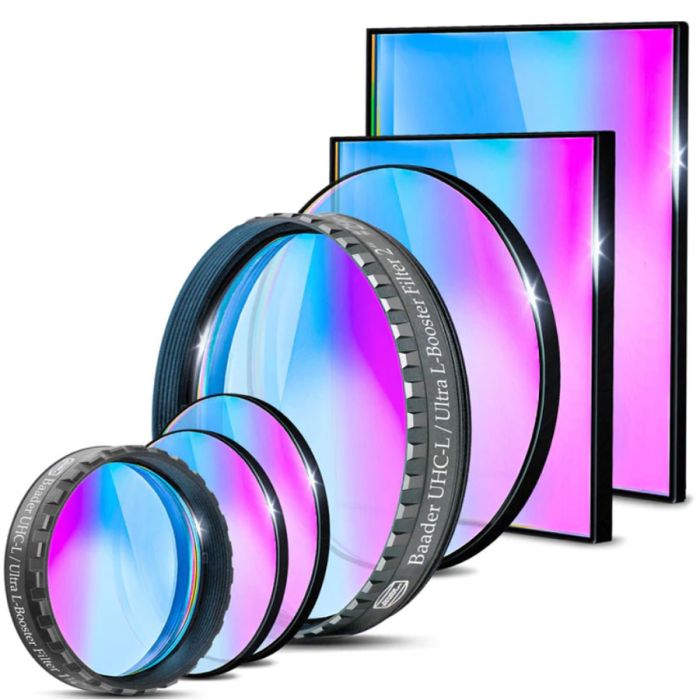Baader UHC-L / Ultra-L-Booster 1.25" Filter
Baader UHC-L / Ultra-L-Booster 1.25" Filter
UHC-L / Ultra-L-Booster Filter Highlights
- Visual and photographic 1¼" UHC-L Nebula filter with highest transmission
- Ultra High Contrast L Filter blocks city lights and increases the contrast of nebula and comets (C2 lines)
- Can be used as LED-optimized Luminance filter for RGB-Imaging with skyglow suppression
- Blue transmission optimized to block blueish skyglow caused by LED car- and streetlights.
- Creates a much brighter image than a conventional Nebula filter
- Ideal for deep-sky observers. This UHC-L filter is the perfect visual complement to narrowband OIII filters.
- Reflex-Blocker™ hard coated and planeoptically polished – with sealed coating edges (Life-Coat™)
- Blackened edges all around, with filter-lead-side-indicator in the form of a telescope-sided black outer rim
The Baader UHC-L filter is the classic all-around "light pollution rejection filter", but is now also blocked against the main LED emissions in the blue part of the spectrum. The passband curve corresponds to a wide dual-band filter without distorting star colors. The two passbands transmit all light emitted by the known gas nebulae (the H-alpha and H-beta lines of fluorescent hydrogen as well as the OIII line of oxygen), while both the atmospheric most disturbing stray light from LED lamps and intense bluish car headlights as well as further stray light from classical street lamps and the natural night sky glow (airglow/skyglow) of the atmosphere are blocked to a large extent. At the same time, the UHC-L filter is coated with the latest technology (CMOS-optimized) and therefore blocks false light much more effectively than all previous UHC filters.
The application of the UHC-L happens mainly in visual and photographic observation of emission nebulae (star-forming regions, planetary nebulae, supernova remnants) under medium to highly polluted skies. Its use is also interesting for comet observation: It passes the OIII line at 501nm as well as the two C2 lines at 511nm and 514nm which are characteristic of the gas tail of many comets.
This UHC-L filter is the successor of the well-proven plane-optical polished Baader UHC-S filter. It consequently complements it with the advantages of CMOS optimization (no disturbing halos, blackened filter edges, Life-Coat™-coating) while providing an improved transmission spectrum adapted to also cover modern LED light pollution. It provides a brighter image than many classic LPR (Light Pollution Rejection) filters and is therefore not only suitable for large, fast instruments but also for smaller telescopes collecting less light, where a large exit pupil cannot be achieved. This applies to long-focal length telescopes as well as to small aperture telescopes that only have an eyepiece socket for 1.25" eyepieces. Unlike the single-line or dual-line narrowband filters, the image is also bright enough for high magnification, while not diminishing the number of stars. For deep-sky observers, therefore, this UHC-L filter is the perfect visual complement to narrowband OIII filters.
The UHC-L filter is also excellent for photographic use. It does not just block polluting terrestrial light sources, but at the same time, it serves as a luminance filter (L-filter), since it blocks all UV and IR transmission like a UV/IR cut filter. An additional UV/IR-cut filter is therefore not necessary: Cameras without a built-in UV/IR-cut filter thus deliver significantly sharper images on refracting telescopes. Both classical photographers and users of EAA/LiveStacking do benefit from the increased sharpness of stars and better contrast of nebulae, as well as the improved transmittance in H-alpha.
Like all Baader CMOS-optimized filters, Baader UHC-L filters likewise are plano-optically polished, with ultra-hard, sputtered dielectric coatings. Even a one-hour bath in boiling water cannot harm these filters! They are scratch-resistant and can be cleaned as often as desired.
The Baader UHC-L / Ultra-L-Booster Filter also offers all the advantages of the CMOS-optimized Baader filters:
- Increased contrast, matched for typical CMOS quantum efficiency and s/n ratio
- Reflex-Blocker™ coatings, for largest ever freedom from halos, even under most adverse conditions concerning aux-optics
- Identical filter thickness to existing standards, with utmost care for parfocality
- Blackened edges all around, with filter-lead-side-indicator in the form of a black frontside outer rim, to additionally eliminate any reflection due to light falling onto the edge of a filter
- Each filter coated individually, with a sealed coating edge (NOT cut out of a larger plate with coatings left exposed
- Life-Coat™: evermore hard coatings to enable a non-aging coating for life – even in a most adverse environment
About Life-Coat
A Baader Planetarium exclusive. Filters incorporating Baader Planetarium’s Life-Coat™ technology are so durable that Baader Planetarium warrants the coatings for the life of the filter. Baader Planetarium has developed Life-Coat™ using materials and processes that result in coatings that will not degrade or fail for a lifetime. Life-Coat™ coatings resist moisture, temperature extremes, and are hardened to withstand normal cleanings.
Baader Planetarium guarantees their Life-Coat™ coatings will not peel, flake, or physically degrade and will withstand repeated cleaning with fine optical cleaning equipment. The Limited Lifetime Warranty applies to the original purchaser and does not cover failure from misuse, physical damage through improper handling, or improper cleaning.
Technical Features
- Transmission Range: Multiple bands (see spectral image)
- Filter Thickness without Cell: 2 mm
- AR-Coating: Reflex-Blocker™ hard coated, planeoptically polished
- Filter Size: 1.25"
- Filter Usage: Contrast Enhancement, Light Pollution Reduction, Luminance
- Filter Mounted?: Mounted (LPFC 6mm)
- Type of Filter: Bandpass
- Single or Set?: Single Filter
- Filter Shape: Round


